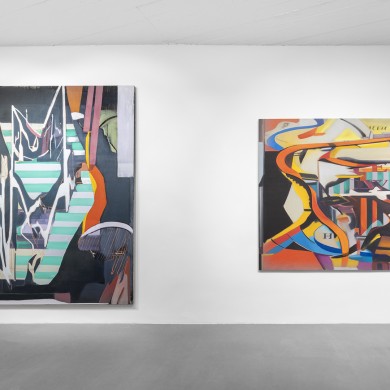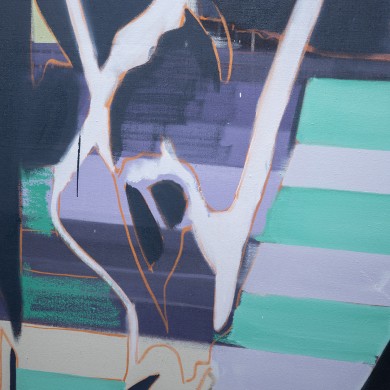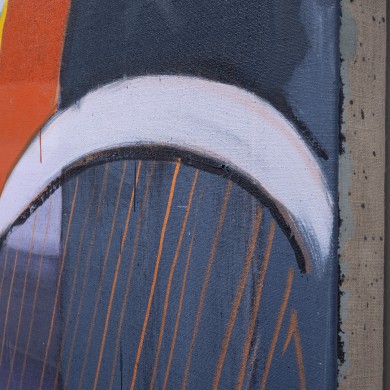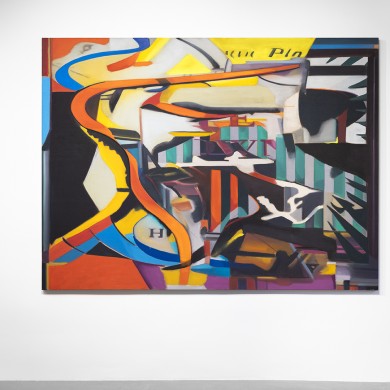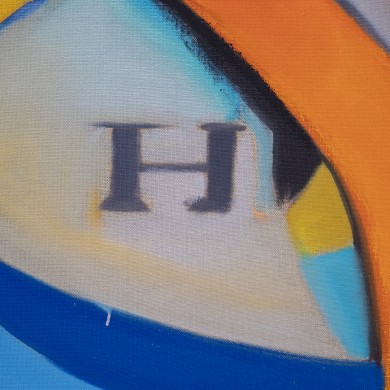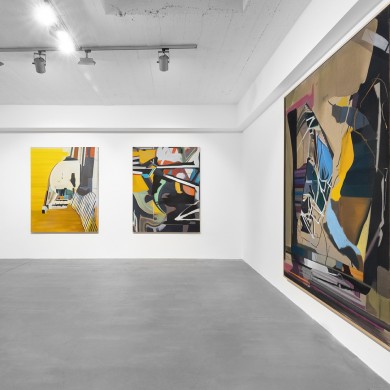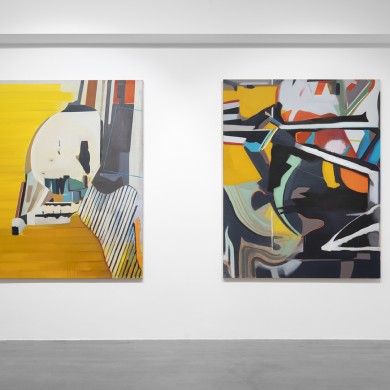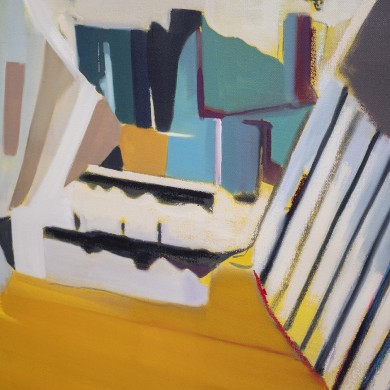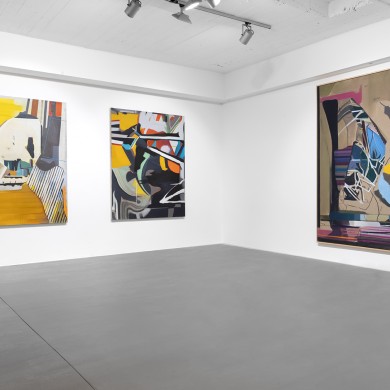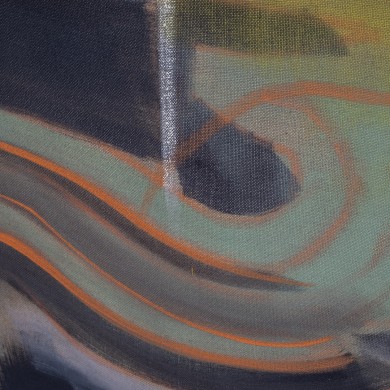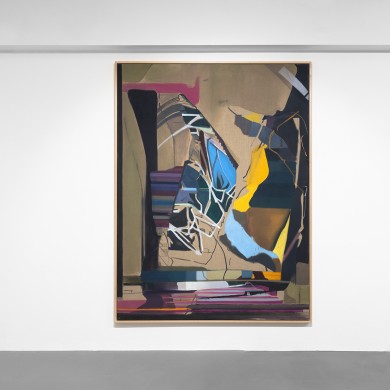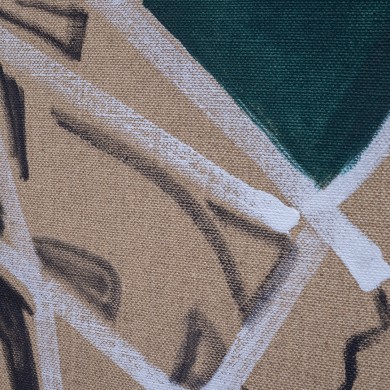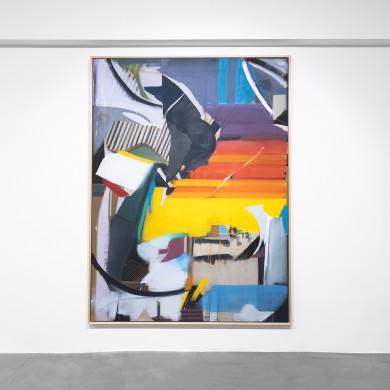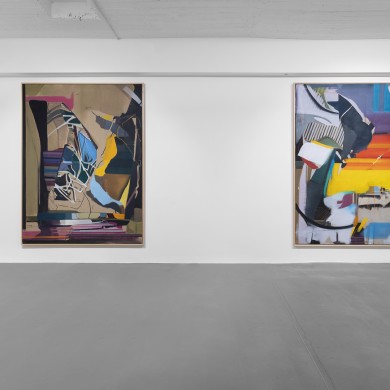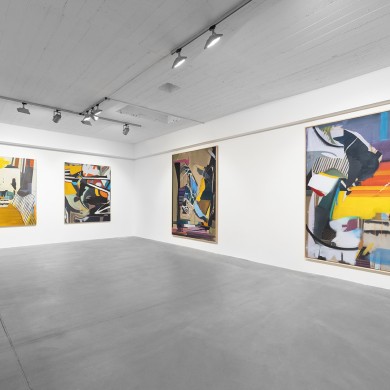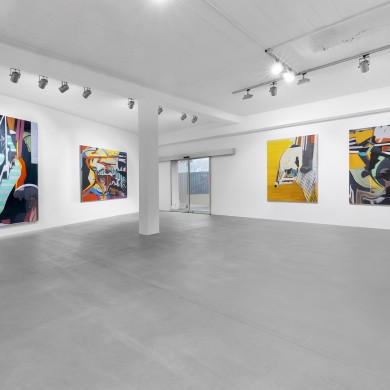IZVOR PENDE
Above Beyond Anything Goes
curator: Silvia Van Espen
10 Dec 2022 – 9 Feb 2023
ZAHORIAN & VAN ESPEN Bratislava
We do not know the world. We have no image of it. If we wished to describe it, we would have to resort to details and fragments, cuttings and different perspectives; we would try to put these together, like Izvor Pende in his pictures, without being able to be sure that this image would represent the world in actual fact. If a real likeness of our fragmentary knowledge is to be counterposed to the illusion of a coherent world-picture, discrete und cut-out pieces must be preserved as a collage. Izvor Pende’s pictures are collages in this sense: painted collages which are devoted to the fragment, seize upon details, and contrast broken bits even while binding them together in a conglomerate.
For Izvor Pende, the brush is simultaneously an instrument for painting and a scissors. Letters, word-remnants, stripes, things which at least bring known objects to mind and signify architectural works or figurative motifs, will be painted and cut out in the same operation. In a new setting, picture for picture, they lose their original significance and become fixtures in a story that employs a language beyond conceptualisation. What remains of its meaning is a hint, more association than identification. Not figures but a figurative something, objective in nature without there being any concrete object one could name. In this respect the pictures are simultaneously abstract: they abstract from their objects, extricating from them the abstract as the fragmentary. And therefore it makes little sense to ask whether the painting found in Izvor Pende’s pictures is figurative or abstract. At one and the same time it is both and neither; these paintings abstract from abstraction just as they do from the figurative, and they declare the abstract itself to be an object of enquiry. With their neither-nor, their also and also-not, they formulate a world-picture that holds up a broken mirror to the vocabulary at our disposal, an experience that has no match in the available description of reality. In this respect, Izvor Pende’s paintings are also concerned with a loss; but they convey no melancholy on this account, nor do they give a painterly funeral oration for lost wholeness. What they express is a present that permits itself to intuit and probe a time beyond the moment, a time that defies the measure of days and hours. How long does an hour last, or a day, and how long does a painting last? What history does yellow or blue have, and what do the lines marked with chalk mean — a sketch that is intended to signify what is coming… or is sketchiness itself the purpose? We do not know, because this knowledge is not adequate to describe what we can nevertheless grasp and perceive (the familiar note that sounds in the colour composition; the play with dissonances and equivalences, which keeps a balance between unequal weights; the strange and astonished feeling when we catch sight of fragments that elude all naming).
Izvor Pende’s art consists in this, that even the strange and astonishing is conceived as familiar experience. His works lend expression to a world where the fragmentary is not the pars pro toto, the part that stands for the whole, but a resource which enables us to reach out a welcoming hand even to motifs and impressions that do not go together (and which the eloquence of well-known concepts cannot put in order) — to be hospitable to them, so that beyond the available identities we may share an unknown time together. For this, Izvor Pende’s paintings are at once celebration and invitation. / Andreas Spiegl
Izvor Pende was born in Zagreb, Croatia.
He began studying sculpture in 1996 at the Academy of Fine Arts in Zagreb. Pende then moved to study painting at Kunstakademie Dusseldorf, receiving his degree in 2002 (Professors Karin Rissa and Markus Lupertz) and his masters degree in 2005. Since 2003, Pende has exhibited his artworks in solo and group exhibitions in Bonn, Munich, Hannover, Dusseldorf and Hamburg in Germany, Chicago in USA, and Eupen, Belgium. In 2005 he won the Ikob – Kunstpreis Nomination and in 2008 the BAT (British American Tobacco) award.
The artistic dialogue with German painter Daniel Richter began in the project “Swimming Together”, where two painters showcased their paintings side-by-side in several museums and institutions, including the Museum of Fine Arts in Split in 2017, the Museum of Contemporary Art in Zagreb and the Museum of Modern and Contemporary Art in Rijeka in 2018. In 2019 Izvor Pende presented his solo exhibition Golden Hours at David Richard Gallery in New York, and in the same year Pende participated in the exhibition Point of Interrupted Departures, together with artists Marijana Pende and Slaven Tolj, which was held during the 58th Venice Biennale in the Pavilion Tesa 100 in the Arsenale, In 2022, he had a solo exhibition at National Museum of Modern Art, Zagreb. Izvor Pende’s artworks are in several museums and in various private collections.
Supported using public funding by Slovak Arts Council ![]()
Svet nepoznáme, nemáme o ňom úplnú či jasnú predstavu. Ak by sme ho chceli opísať, museli by sme sa spoliehať na detaily a fragmenty, na úseky a rozdielne perspektívy, ktoré by sme sa – podobne ako Izvor Pende vo svojich maľbách – snažili poskladať bez toho, aby sme si boli istí, či by tento obraz potom skutočne reprezentoval svet. Ak by sa klamná ilúzia súdržnej predstavy sveta mala vyrovnať skutočným obrazom nášho fragmentárneho poznania, fragmentárne a úryvkové musí byť uchované ako koláž. V tomto zmysle sú obrazy Izvora Pendeho koláže – maľované koláže, ktoré sa oddávajú fragmentu, zachytávajú detaily a kontrastujú zlomy, rovnako ich aj spájajú do nového celku.
Izvor Pende používa štetec nielen ako maliarsky nástroj, ale zároveň ako nožnice. Písmená, fragmenty slov, pruhy a to, čo prinajmenšom pripomína známe predmety a evokuje architektúru alebo figuratívne motívy, je súčasne maľované aj strihané. V stále novom prostredí, obraz po obraze, stráca svoj pôvodný význam. A stáva sa tak vhodným kúskom príbehu, ktorý používa jazyk presahujúci terminológiu. Z ich významu pretrváva náznak, skôr asociácia ako identifikácia, niečo na spôsob reprezentácie bez vyslovenia slova pre konkrétny predmet. A tak otázka, či sú obrazy Izvora Pendeho figuratívne alebo abstraktné, nedáva zmysel. Sú súčasne oboje a ani jedno, abstrahujú abstraktné aj figuratívne a samotné abstraktné vyhlasujú za predmet spochybňovania. Ani – ani, „tiež a ani“ artikuluje svetonázor, ktorý nastavuje rozbité zrkadlo nášmu dostupnému slovníku, zážitok na nerozoznanie v dostupnom opise reality. V tomto ohľade sa maľby Izvora Pendeho vyrovnávajú aj so stratou, ktorú nesprevádzajú melanchóliou či malebným chválospevom na stratenú celistvosť, ale skôr prítomnosťou, ktorá umožňuje precítiť moment, precítiť čas, ktorý je mierou dní a hodín. Ako dlho trvá hodina, deň a ako dlho trvá maľba, obraz? Aká je história žltej alebo modrej a aký význam majú čiary nakreslené kriedou – skica, ktorá má iba naznačiť, čo príde, alebo je cieľom už samotná skicovitosť?
To nevieme, pretože tieto poznatky nestačia na to, aby sme opísali to, čo však dokážeme uchopiť a vnímať: to, čo nám je dôverne známe, čo rezonuje vo farebnej kompozícii. Hra s disharmóniou a rovnováhou, ktoré balansujú to, čo má rôznu váhu, zvláštnosť a odcudzenie pri pohľade na fragmenty, ktoré vzdorujú pomenovaniu.
Umenie Izvora Pendeho spočíva v uchopení neznámeho a neobvyklého ako známej skúsenosti, vo vyjadrení sveta, v ktorom fragmentárnosť nie je súčasťou celku, ale zdrojom. Zdrojom, ktorý nám umožňuje priblížiť sa k pohnútkam a dojmom, ktoré nezapadajú do výrečnosti známych pojmov. Pozvať ich, aby spolu strávili nepoznaný čas nad rámec svojich dostupných identít. V tomto je tvorba Izvora Pendeho oslavou a pozvánkou zároveň. / Andreas Spiegl
